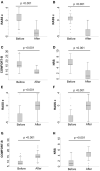Validity and Reliability of the Richmond Agitation-Sedation Scale in Pediatric Intensive Care Patients: A Multicenter Study
- PMID: 35047463
- PMCID: PMC8762108
- DOI: 10.3389/fped.2021.795487
Validity and Reliability of the Richmond Agitation-Sedation Scale in Pediatric Intensive Care Patients: A Multicenter Study
Abstract
Background: There is limited data about the psychometric properties of the Richmond Agitation-Sedation Scale (RASS) in children. This study aims to analyze the validity and reliability of the RASS in assessing sedation and agitation in critically ill children. Methods: A multicenter prospective study in children admitted to pediatric intensive care, aged between 1 month and 18 years. Twenty-eight observers from 14 PICUs (pediatric intensive care units) participated. Every observation was assessed by 4 observers: 2 nurses and 2 pediatric intensivists. We analyzed RASS inter-rater reliability, construct validity by comparing RASS to the COMFORT behavior (COMFORT-B) scale and the numeric rating scale (NRS), and by its ability to distinguish between levels of sedation, and responsiveness to changes in sedative dose levels. Results: 139 episodes in 55 patients were analyzed, with a median age 3.6 years (interquartile range 0.7-7.8). Inter-rater reliability was excellent, weighted kappa (κw) 0.946 (95% CI, 0.93-0.96; p < 0.001). RASS correlation with COMFORT-B scale, rho = 0.935 (p < 0.001) and NRS, rho = 0.958 (p < 0.001) was excellent. The RASS scores were significantly different (p < 0.001) for the 3 sedation categories (over-sedation, optimum and under-sedation) of the COMFORT-B scale, with a good agreement between both scales, κw 0.827 (95% CI, 0.789-0.865; p < 0.001), κ 0.762 (95% CI, 0.713-0.811, p < 0.001). A significant change in RASS scores (p < 0.001) was recorded with the variance of sedative doses. Conclusions: The RASS showed good measurement properties in PICU, in terms of inter-rater reliability, construct validity, and responsiveness. These properties, including its ability to categorize the patients into deep sedation, moderate-light sedation, and agitation, makes the RASS a useful instrument for monitoring sedation in PICU.
Keywords: anesthesia and analgesia; intensive care unit; monitoring; nursing assessment; pediatric; physiologic; reproducibility of results; validation studies as topic.
Copyright © 2022 Tapia, López-Herce, Arias, del Castillo and Mencía.
Conflict of interest statement
The authors declare that the research was conducted in the absence of any commercial or financial relationships that could be construed as a potential conflict of interest.
Figures


References
-
- Harris J, Ramelet AS, van Dijk M, Pokorna P, Wielenga J, Tume L, et al. . Clinical recommendations for pain, sedation, withdrawal and delirium assessment in critically ill infants and children: an ESPNIC position statement for healthcare professionals. Intensive Care Med. (2016) 42:972–86. 10.1007/s00134-016-4344-1 - DOI - PMC - PubMed
LinkOut - more resources
Full Text Sources

